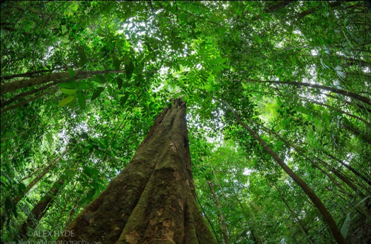About fifty to ninety percent of existences in the rainforests are regarded in the trees, above the shaded forest surface. Main tropical rainforest is vertically divided into five classes: the overstory, the canopy, the understory, the shrub layer and the forest floor. Each class has its own extraordinary animal and plant species blending with the ecosystem surrounding them.
The overstory denotes to the crowns of emergent trees which grows up to a hundred feet above the rest of the canopy. On the other hand, the canopy is the thick ceiling of closely spaced branches and their trees, while the understory denotes a widely spaced, minimal tree species and individuals that compose a broken layer below the canopy. The shrub layer showcases shrubby species and minimal trees that grow with a maximum height of twenty (20) feet off the forest floor. In other words, this is the ground layer of the forest made up of the tree trunks, low growing vegetation and fungus. This layer varies from forest to forest, but is considered as an efficient component of the mechanical and vegetative forest structures.
The overstory showcases a scattered emergent trees that umbrella above the rest of the canopy. This exceeds more than two hundred ten (210) feet. On the other hand, below the overstory trees lies the canopy which broadens from wide distances. This has an effect of seamlessness when observe from above. But despite the overlapping tree branches, canopies rarely touch each other. They are somehow separated from one another seemingly respecting each area. Why the branches of these trees do not touch is still a mystery up to this point, but studies have shown that it is a protection from infestations and other insects and diseases such as blight on the leaves. In order to survive, dwellers in the canopy must have the capability to negotiate these gaps by leaping, climbing, flying, or gliding.
The hundreds of thousands of leaves of the canopy, acting as small solar panels, supplies the source of power for the forest by translating sunlight to energy by the process of photosynthesis. Photosynthesis is the method by which plants translate atmospheric carbon dioxide and water into simple sugars and oxygen. And because there are high rates of photosynthesis of canopy trees, these plants have higher yield of seeds, leaves, fruits and flowers that support and attract an array of diversity of animal life. Aside from attracting a plethora of wildlife, the canopy plays a crucial role in managing global and regional climate because it is the main site of the heat interchange, atmospheric gases and water vapor.
To add to gathering solar energy and maintaining such climate, the canopy shields the understory from intense and harsh sunlight, heavy rainfall, drying winds, and maintains the moisture of the forest below. Thus, the forest interior is way volatile environment as compared to upper parts of the canopy.
Truly indeed, the beauty of the rainforest through its canopy is a god-given gift. We may not understand its magic, but it is proven to be contributing to the betterment not only of the surroundings inside the canopy, but also beyond it.
“le radeau des cimes” studying the canopy


